ARCHIVE - Access to Information Act Annual Report 2008-2009
Archived Content
Information identified as archived is provided for reference, research or record-keeping purposes. It is not subject to the Government of Canada Web Standards and has not been altered or updated since it was archived. Please contact us to request a format other than those available.
Table of Contents
Report on the Access to Information Act
About Public Safety Canada
Public Safety Canada (PS) was created in 2003 to provide leadership and coordination across all federal departments and agencies responsible for the safety of Canadians. The Department delivers a range of programs related to national emergency preparedness, critical infrastructure protection and community safety. Working towards a safe and resilient Canada, the Department provides leadership, coordinates and supports the efforts of federal organizations responsible for the national security and safety of Canadians. The Department also works with other levels of government, first responders, community groups, the private sector and other countries to achieve its objectives.
To keep Canadians safe from a range of threats, the Department provides strategic policy advice and support to the Minister of Public Safety on issues related to public safety, including: national security; emergency management; policing and law enforcement; interoperability and information-sharing; border management; corrections and conditional release; Aboriginal policing; and, crime prevention.
Providing strategic public safety leadership, the Department works within a portfolio consisting of five agencies and three review bodies. These entities, including the Department, are united under the Public Safety Portfolio and report to the same minister, resulting in enhanced integration among federal organizations dealing with public safety issues. The Department supports the Minister in all aspects of his mandate and plays a national public safety leadership role while respecting the separate accountability of each Portfolio agency.
Also situated within the Department is the Office of the Inspector General of the Canadian Security Intelligence Service (CSIS), which carries out independent reviews of CSIS' compliance with the law, Ministerial direction and operational policy.
About the Public Safety Portfolio
The Public Safety Portfolio is responsible for public safety within the Government of Canada and consists of five agencies: the Canada Border Services Agency, the Canadian Security Intelligence Service, the Correctional Service of Canada, the National Parole Board, and the Royal Canadian Mounted Police (RCMP). It also includes three review bodies: the RCMP External Review Committee, the Commission for Public Complaints Against the RCMP, and the Office of the Correctional Investigator.
Each portfolio agency, review body, as well as IGCSIS, submit separate annual reports to Parliament on the administration of the Access to Information Act and the Privacy Act.
About the Access to Information Act
The Access to Information Act wasimplemented on July 1, 1983. The Act gives the public a broad right of access to information contained in federal government records, subject to certain limited and specific exceptions.
Section 72 of the Access to Information Act requires that the head of every government institution submit an annual report to Parliament on the administration of the Act during the financial year. This report outlines how Public Safety Canada administered the Access to Information Act throughout fiscal year 2008-2009.
The Access to Information and Privacy (ATIP) Unit
The Access to Information and Privacy (ATIP) Unit is part of Public Safety Canada's Executive Services Division within the Department's Strategic Policy Branch. It is comprised of one Manager, four analysts and two administrative officers. The Director, Executive Services, served as the Department's ATIP Coordinator throughout the reporting year, in addition to directing the Department's Ministerial Correspondence and Speech-writing Units.
The ATIP Unit is responsible for the coordination and implementation of policies, guidelines and procedures to ensure departmental compliance with the Access to Information Act and the Privacy Act. The Unit also currently provides the following services to the Department:
- Delivers ATIP awareness sessions to departmental employees
- Processes consultations received from other institutions
- Provides advice and guidance to employees and senior officials on ATIP related matters
- Provides support to the Minister of Public Safety by providing release packages received from the portfolio and advising senior officials of releases of personal information by portfolio agencies pursuant to section 8(2)(m) of the Privacy Act
- Prepares an Annual Report to Parliament
- Coordinates updates to Info Source manuals
- Reviews departmental documents, such as audits and evaluations, prior to proactively disclosing these on the departmental website
- Develops internal procedures
- Maintains the ATIP reading room on behalf of most institutions in the Public Safety portfolio
- Participates in forums for the ATIP community, such as the Treasury Board Secretariat ATIP Community meetings and working groups
Delegation of Authority
The responsibilities associated with the administration of the Access to Information Act, such as notifying applicants of extensions and transferring requests to other institutions, are delegated to the departmental ATIP Coordinator through a delegation instrument signed by the Minister of Public Safety. The approval of all exemptions remains with the Deputy Minister, the Associate Deputy Minister, the Senior Assistant Deputy Minister and all Assistant Deputy Ministers.
A detailed delegation instrument is at Annex A.
Highlights and Accomplishments for 2008-2009
Public Safety Canada has continued to improve the way in which the Department responds to ATI requests, by focusing on improving timeliness, efficiency and accuracy. We implemented concrete measures in FY 2007-2008 that allowed us to achieve these goals, and we continued to build on these improvements over the year. Some of the highlights are as follows:
- All available standard classes of records and standard Personal Information Banks (PIBs) were identified in Info Source. The ATIP Unit led a departmental working group with representatives from each branch, as well as experts from the Department's Information Management group to update the Department's institution specific classes of records descriptions and PIBs. The group's work is ongoing, and Public Safety expects that some of the required updates will be reflected in the 2009 Info Source publication.
- The Department's Management Committee was briefed on the status of the Department's information holdings as well as its obligations. The Committee agreed that the Department would continue registering required standard banks, ADMs would review the entries in Info Source to validate their currency, and the Department would respect statutory requirements in relation to any new program activities from this point forward.
- The Department has further engaged ADMs around timeliness of responding to ATIP requests through weekly reporting to senior management and quarterly reporting on meeting retrieval deadlines by Branch.
- The ATIP Unit moved its operations in November 2008 to the Department's headquarters at 269 Laurier Avenue West. The move has benefited the Department's performance on ATIP matters by improving access to Offices of Primary Interests (OPIs) and reducing the overall time needed to route most dockets.
- Despite a significant increase in consultations during this past year, the Department has remained committed to on-time performance in the face of the continued high volume of requests.
Challenges
Staffing
The ATIP Unit modified its organizational structure to allow greater flexibility in recruitment and is considering the creation of developmental positions in order to retain experienced employees while allowing for career progression. As with most federal institutions, recruitment and retention of qualified ATIP professionals continues to be a significant challenge. The challenge at Public Safety is further complicated by the requirement that many ATIP staff require security clearances at the very highest level given the nature of the Department's business.
Public Safety continues to examine resources in the ATIP Unit.
Access to Information Act Statistical Report
Overall Workload Trends
Annex B provides a summarized statistical report on Access to Information Act requests processed by Public Safety Canada between April 1, 2008 and March 31, 2009. The following section reviews and interprets the statistical information by analyzing workload trends.
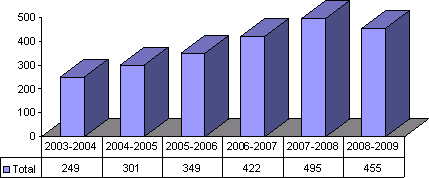
Over the past six years, the workload for the ATIP Unit has doubled. FY 2008-2009 saw a slight decrease in total volume from the previous year. Totals include formal Access and Privacy requests, and consultations from other institutions. The figures do not reflect requests processed informally or other services that the ATIP Unit provides to the Department.
Public Safety Canada plays a role in coordinating activities involving federal institutions within the Public Safety portfolio as well as with other organizations at all levels of government on matters relating to the safety of Canadians. Consequently, the Department processes nearly as many consultation requests from other institutions as formal ATIP requests. ATI-related work continues to dominate the ATIP unit's workload.
The following graph provides a categorical breakdown of workload trends over the past six years.
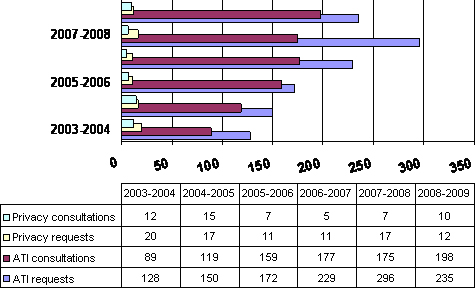
Requests Received under the Access to Information Act
Public Safety Canada received two hundred and thirty-five (235) new Access to Information requests throughout the 2008-2009 fiscal year, representing a slight decrease in the number of requests received the previous year (296). Fifty-nine (59) requests were carried forward from the previous fiscal year, resulting in a total of two hundred and ninety-four (294) requests to process during 2008-2009. Two hundred and forty-two (242) of these requests were completed during the reporting year, while the remaining fifty-two (52) requests were carried forward to the next reporting year.
The following graph illustrates the number of formal requests received by the Department.
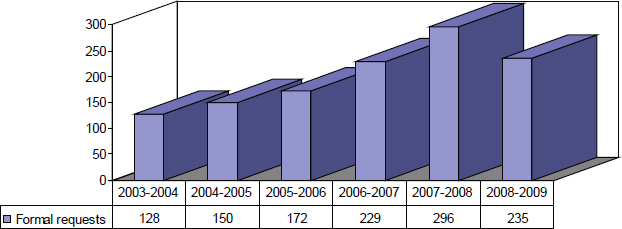
Source of Requests
Media dominated the source of requests received by Public Safety Canada for the 2008-2009 fiscal year. Of the two hundred and thirty-five (235) requests received, the media comprised 55% of that number (130). Members of the public who did not identify themselves as belonging to any other category accounted for 25% of requests (59), and 12% were received from organizations (29). A small percentage of requests were submitted from businesses (5) and academia (12), at 3% and 5% respectively.
The following graph details the breakdown of requests received by each group, and the percentage of the total requests they represent.
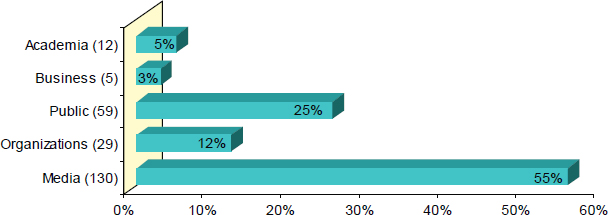
Extensions
Section 9 of the Access to Information Act allows institutions to extend the legal deadline for processing a request if a search for responsive records cannot be completed within 30 days of receipt of the request, or if the institution must consult with other institutions or third parties.
Public Safety Canada plays a role in coordinating activities involving federal institutions within the Public Safety portfolio as well as with other organizations at all levels of government on matters relating to the safety of Canadians. Extensions in excess of 90 days are therefore often necessary in order to undertake the required consultations.
The Department invoked a total of ninety-four (94) extensions during the 2008-2009 fiscal year, and eighty-seven (87) of these were for more than 31 days. Four (4) extensions were invoked due to the high volume of records involved. Eighty-nine (89) extensions were required in order to undertake consultations with other federal institutions, and one (1) was required for third party notification.
Of the two hundred and forty-two (242) requests completed over the year, one hundred and forty-eight (148), or 61%, of requests were completed in 30 days or less, while ninety-four (94), or 39%, were completed beyond thirty days. Seventeen (17) requests required a 31-60 day extension and twenty-two (22) required extensions of 61 to 120 days. Fifty-five (55) requests were extended for 121 days or more.
Disposition of Requests for 2008-2009
As many of the documents processed by Public Safety Canada's ATIP Unit contain sensitive information relating to national security and law enforcement, as well as advice to the Minister and Cabinet records, the majority of departmental responses contain exempted and/or excluded information.
The following graph identifies the disposition of requests completed during the year.
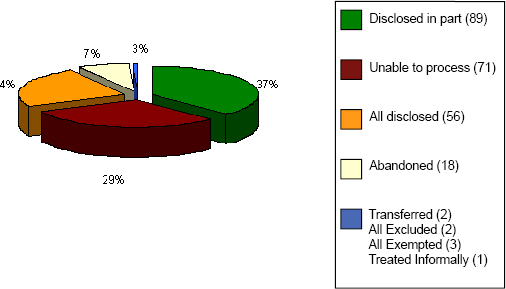
Consultations from Other Institutions
The Department's role in coordinating with other federal institutions as well as those within the Public Safety portfolio has resulted in the Department having a greater interest in the records processed by other institutions. A significant amount of the ATIP Unit's workload involves responding to consultations in response to formal requests received by other institutions. These responsibilities are not reflected in the ATIP Unit's current resource levels.
While the number of formal ATI requests decreased over the reporting year, consultations from other institutions increased significantly. The following graph details the increase in the number of consultations from other federal institutions since the Department was created in December 2003.

Investigations
The Office of the Information Commissioner notified Public Safety Canada of fifty-eight (58) complaints received throughout 2008-2009. This number represents a 62% percent increase from the previous year, during which time thirty-six (36) complaints had been received. The Department attributes this increase to delays at the Office of the Information Commissioner in entering new complaints received by their office in
2007-2008. Over the last three years, the Department averaged forty-six (46) complaints per year.
Half (29) of the complaints received concerned the length of extension invoked, while sixteen (16) complaints were registered under the category “denial of access” because the Department had notified requesters that records responding to the requests could not be located. Twelve complaints (12) concerned the exemptions/exclusions applied to withhold information and one complaint was pertaining to delay.
A total of thirty (30) complaints were completed during the reporting period. The Information Commissioner's findings with respect to the complaints were as follows:
- one (1) complaint of denial of access was not well founded;
- one (1) complaint regarding the application of exemptions and/or exclusions was resolved; and
- of the twenty-eight (28) complaints received on time extensions, six (6) were resolved, three (3) were not well founded, and nineteen (19) were discontinued.
Appeals to the Court
There was one appeal to the Federal Court for fiscal year 2008-2009. The matter is ongoing.
Training
The Department focused on furthering ATIP awareness in 2008-2009. The ATIP Unit delivered a total of 8 two-hour information sessions with a total of 80 people attending the sessions. The ATIP Unit also created training materials that focus both on ATI requirements and departmental procedures for processing ATI requests. These documents are now available to Public Safety employees through the intranet site. The ATIP Unit also provides ongoing individualized training on departmental procedures to Public Safety Canada's employees who assume ATIP responsibilities. The Department hopes to expand its resources to be able to provide more frequent and comprehensive training sessions for employees as well as develop training materials and resources.
Informal Processes
Whenever possible, information is provided informally to the public by departmental employees. For example, the Communications Directorate responds to many requests for information from the media and the Canadian public. Additionally, the departmental website serves as a valuable source of information, where contracts over $25,000 and expenses of senior officials are routinely updated. Given the sensitivity of much of the information held in Public Safety Canada, there are few opportunities to disclose other types of information informally.
Public Reading Room
The Access to Information Act requires that institutions maintain a reading room where the public can review records. Records released under the ATI Act in the current year, as well as those released during the preceding two years are available for viewing at no charge. Photocopying costs are applied at $0.20 per page. The reading room is located at 269 Laurier Avenue West, 11th floor, Ottawa, Ontario. Access to the facilities are available by appointment only from Monday to Friday between 10am and 3pm, holidays excepted.
Annex A:
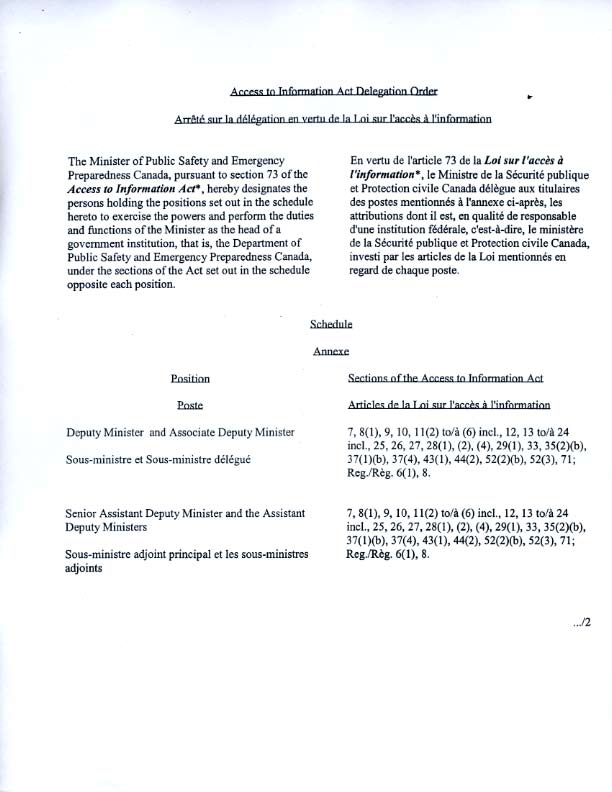

Annex B:

Supplemental Reporting Requirements for 2008-2009
In addition to the reporting requirements addressed in form TBS/SCT 350-62 “Report on the Access to Information Act”, institutions are required to report on the following using this form:
Part III - Exemptions invoked
- Section 13
- Subsection 13(e): 0
- Section 14
- Subsections 14(a) 2
- Subsections 14(b) 2
- Part IV - Exclusions cited
- Subsection 69.1 (1) 0
- Date modified:
